
FRUIT EXPLORATION IN SOUTH AMERICA
It was my greatest desire to visit South America, especially the Amazon region from where I have been told that some of the best fruit came from.
My first touchdown in South America was in Lima, the capital of Peru, being situated not too far from the Equator near the coast at 30 metres altitude. To my surprise, it has a rather cool climate, too cool for coconuts to grow there, and I have not seen any unusual fruits there. Also their currency is difficult to get used to as the inflation rate is over 100% per annum. At that time $1 was equal to one million Intis, so you are dealing with millions of Intis. If you are purchasing anything, one needs to also get used to the possibility of robberies which are very common here. They are professional thieves.
From the capital, I flew to Iquitos situated in the Peruvian Amazon. This is the place I have heard a lot about and was anxious to see what fruit types they have. There was a huge market with fruits and other merchandise near the river where all the ships are unloaded, but as far as the fruits are concerned, there were mainly only common fruits available with the exception of the Amazon tree grape which I tasted for the first time, and some extra large Rollinias.
Two other fruit types I bought to try out tasted so horrible I threw them away. So fruit-wise, Iquitos has nothing unusual to offer except for medicinal plants which are very popular there, as most of the people are too poor to buy drugs from the chemist for certain illnesses.
They are using natural plant material such as leaves, bark, roots coming from plants out of the jungle. Some of these plants have been made into liquid and are now available in bottles. These medicinal plants take over a big part of the market place.
I went with a guide up the river, visiting 2 Indian communities, walking for hours through the forest which had once been cleared but is growing bush again quite tall. However the wild animals and the fruit trees that once grew there are lost forever, and all that appears in the markets are a few common fruit types grown by the Indian communities.
I travelled a lot through the mountains at altitudes of around 4000 metres where most of the Indian communities are living. The only unusual fruit I have seen here was the Capuli Cherry, which looks identical to the cold-hardy cherry we are all familiar with. I must say that it tastes equally good, although some who grow it here in Australia claim it to be inferior. This could be due to the difference in the climatic conditions. In its natural habitat at 3,500 metres, it is warm to hot during the day and freezing cold at night.
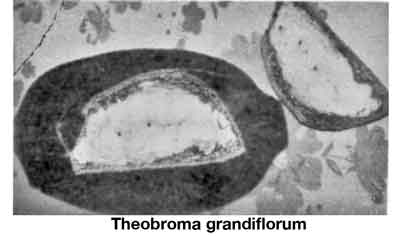
The coastal strip south of Lima is all desert, and this desert is being used for extensive farming irrigated with the water running off the mountains. From here I went to Brazil. My first stop was Belem, situated on the Atlantic side of the Amazon river, and to my surprise there was a huge market taking over many streets and with a large variety of different and rare fruits and nuts. Just to name a few of these: Theobroma grandiflorum, common name 'Cupuaçu,' which is a very important fruit over here, particularly when it is made into a juice. This fruit has an exceptionally good flavour that is liked by all and the fruit itself is quite large, being about the size of a small jakfruit. It has a hard brown shell on the outside which is easily broken with a piece of wood. This is what the locals do. This fruit is also good to eat fresh straight out of hand without discomfort. However as it is lacking in sweetness, it is best eaten by sprinkling a bit of sugar over it, which makes it one of the most delicious fruits. The acidity of this fruit is low, not more than that of an orange. Most frequently this fruit is being used for ice cream and for juicing for which they add some sugar and ice. It's being sold in milk bars right across the Amazon under the name 'Sucos de Capuaçu'. I personally liked this so much that when I went to have a drink, I ended up having 5 to 6 drinks, which was equal to a delicious meal - even an hour later I still felt a good after-taste.
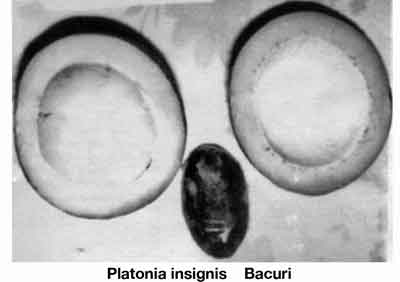
Another fruit I liked very much was the Platonia insignis - common name 'Bacuri'. It is a fruit the size and shape of a large duck egg, green to yellowish on the outside with a few large seeds. The covering on the outside is very thick and the flesh around the seeds is thin, about 5 mm thick but extremely tasty. This fruit is also being used for ice cream.
Another fruit in plentiful supply was Rheedia macrophylla - common name, Bacuri-Pari. This R. macrophylla is different from the Macrophylla which is known in Florida, which is not the true Macrophylla. This particular one is also delicious to eat with low acidity and good flavour. However the flesh is not very thick. The fruits are about 1½" in diameter and of a brown-yellowish colour.
There were also many Brazil nuts for sale, and unlike the Brazil nuts we know in Australia, these ones were fresher, much softer and tastier.
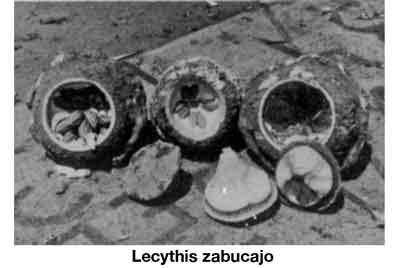
From here I travelled further west of the Amazon where I came across some more very interesting fruits and nuts. When I arrived at the market place, I saw a whole truckload full of Sapucaia nuts (Lecythis zabucajo). These nuts are in huge pots with a lid on one end, and when the lid becomes detached, all the nuts start to fall out. A pot may have an average of 40-45 nuts. They are corrugated lengthwise and about 3 inches long. It is one of the largest nuts I have seen, being about twice the size of the Brazil nut and these nuts taste very good. They usually arrive in a green state with the lid still attached to the pot. To get the nuts out, they hit the whole pot against concrete and the lid comes off and one can dig out all the nuts one by one which are attached to an inedible mass. I was going to bring one empty pot back to Australia but they were SO huge and heavy to carry around with me that I had to leave it behind. It was also possible to purchase these nuts in a loose form.
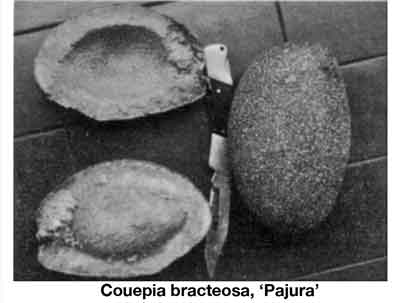
Another fruit called Couepia bracteosa - 'Pajura', turned out to be the most delicious fruit and probably the newest, as it was only to be found in this particular location. It is the size of a large duck egg. It is brown on the outside with many white dots all over it. It has a large seed in the centre similar to an avocado. In fact, many aspects of this fruit are very similar to an avocado. However the flesh does not appear to be fatty like an avocado. It is more like the flesh of a Canistel. However in my opinion this fruit, without adding sugar or anything, tastes better than either of those two fruits. It is also very filling. The most I could eat at any one time were 2 fruits.
Another fruit is Theobroma subincanum - the 'Cupui'. This fruit is similar to the Cupuaçu to which it is related. The difference being that the fruit is only about 1/3 the size and a more yellowish-brownish colour on the outside, and the flesh being sweet, which makes it easier to eat straight out of hand. There were other rare fruit types but of lesser importance.
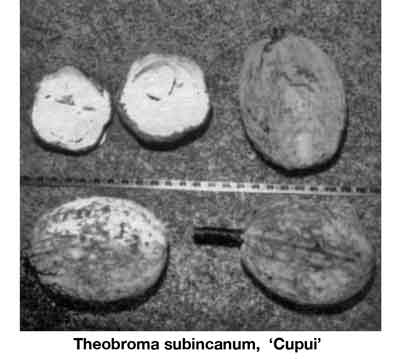
From here I travelled to Manaus. It has a population of 1.2 million people being the largest city of the Amazon. During the time of the rubber boom, it was a very rich city with extraordinary buildings, including the famous Opera House which has been restored. Also there are many holes in the street and footpaths and the gutters are littered with rubbish. However I went with a guided tour into the jungle. We could see some old rubber plantations which have not been in use for a long time and were completely overgrown by jungle. From what they told me, there was not enough profit any more in the rubber industry. Although they work on low wages, the operating costs are much higher than anywhere else in the world. The city market was rather small and nothing unusual was offered that I could not have had anywhere else.
From here, I took a trip by boat up and down the river over 3 days, and our guide took us for many jungle walks. He explained to us all the various trees and all the different ways they can be used; there was just about a tree for any purpose that may arise. For example, there is a thick hardwood vine which contains a large quantity of water, so that when one section is cut out, you can let the water run straight into your mouth. Another tree they used to make oil from: one ton of timber makes 3 litres of expensive oil. Another small tree was used for making blow pipes, and it was perfectly straight with a hard exterior and a soft interior which is removed. The guide showed us plants from which the juice is used for snake bites. He also showed us the plants they use to make poison for the poison darts etc.
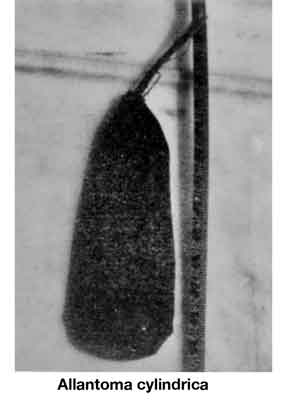
While walking through the jungle, I noticed several Sapucaia trees by the empty pots that were lylng on the ground as well as by the thick rough bark, identical to that of an oak tree. I also came across another closely related nut tree called the Allantoma cylindrica, which has a similar pot with a lid on one side. It has a thick centre core on the inside to which more than 100 nuts were attached, about the size of a pea.
I took another trip from Manaus. this time by bus, 200 kms east on a good bitumen road to Itacoatiara, passing many farms on both sides, and some sections of forest. From here, I went 14 kms up the river and this was as deep in the jungle as I have been. I saw Brazil nut trees, more monkey pot trees and we did some piranha fishing.
From here, I went to Rio de Janeiro where I spent nearly one week in the Botanic Gardens. It is one of the great botanic gardens with lots of fruit trees. One of particular interest to me was Lecythis pisonis. There were 7 of these trees growing there for a long time as they were amongst the tallest trees in the garden, one having a trunk diameter of about 1½ metres. All of these trees were full of pots in advanced stages and the ground was covered with pots from the previous year. There was also one tree of Lecythis paraensis. One of the staff from the botanic gardens came to show me all the other various fruit trees. He removed from the tree 2 pots of Lecythis pisonis with the lid still attached, as well as some Mammea americana fruits for me to take home to Australia. We also had a feast of jakfruit. Then he took me to the Herbarium where they had 3 large showcases on display with many various types of Lecythis-related pots and fruits from all over Brazil. Old records showed that at one stage, they had several other types of Monkey Pot trees growing in the garden, which however have died in the meanwhile. There is also a library in the botanic gardens with books on all the various trees and the history of the gardens.
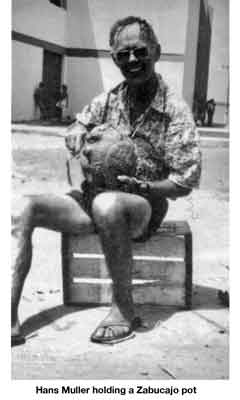
Of special interest to me was a book describing. in great detail. all the various types of Monkey Pot trees from all over South America. This book also had photographs of all these pots and nuts as well as a map of the location where they occur. Four of these were of great interest to me, as as they grow naturally as far south as Rio de Janeiro, which should make them fairly cold-hardy. These ones were L. pisonis, L. lanceolata, L. schwackei and L. lurida. Fortunately, this book was all in English and published in New York.
There was no market place for fruits and vegetables in Rio, neither could I find one fruit shop. The only few fruits available were being sold in very few street stalls or supermarkets. There was a fruit market in São Paulo, however they had only common fruit available. The same as for Iguazu, where I went to see the waterfall, but did not notice any unusual fruit.
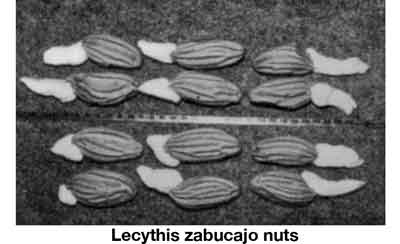
DATE: July 1992
* * * * * * * * * * * * *
